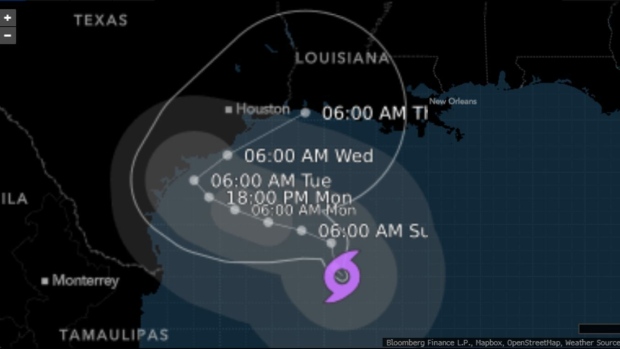Sep 19, 2020
Tropical Storm Beta Will Drench Texas, Louisiana With Heavy Rain
, Bloomberg News

(Bloomberg) -- Slow-moving Tropical Storm Beta is likely to reach hurricane strength as it meanders across the western Gulf of Mexico and Texas coast, bringing heavy rain as far as Louisiana, as well as raking off-shore energy fields with high winds next week.Winds from Beta could hit 80 miles (129 km) per hour by Monday, making it a Category 1 hurricane on the five-step Saffir-Simpson scale as it nears Corpus Christi, Texas. It’s likely to make landfall there or possibly stay just offshore, the U.S. National Hurricane Center said in a Saturday advisory.
Category 1 Hanna also struck southern Texas this year, the first hurricane to make landfall in the Lone Star state since Harvey in 2017 and the first to hit in July since Dolly in 2008.
Beta is forecast to drift along the coast toward the Galveston-Houston area, where it could flood low-lying areas, and may even menace parts of the Louisiana coast that were devastated by Hurricane Laura a month ago. It’s likely that Beta will bring as much as 12 inches (30 centimeters) of rain along the coastline as it drifts north.“It is a slow moving system,” said Aaron Carmichael, a meteorologist with commercial forecaster Maxar. “The biggest concern is probably going to be the rainfall.”
Beta is the Atlantic’s 23rd storm for 2020 so far, the second most active season in records going back to 1851. So many storms have formed that the hurricane center has used up all the names on its official list and has begun designating new storms with Greek letters.
Tropical Storm Alpha formed Friday off Portugal, whipping up high winds that briefly suspended play in a golf tournament there, and has since fallen apart.
Summer of Trouble
While its exact track is still uncertain, if Beta came ashore in Texas it would be the ninth storm to hit the U.S. this year, tying a record set in 1916, said Phil Klotzbach, lead author of the Colorado State University seasonal forecast.
The 2020 summer has brought a string of natural disasters to the U.S., from hurricanes and tropical storms to a derecho that left wreckage from Iowa to Indiana, to fires in the West that have killed dozens of people and scorched millions of acres.
Carmichael said Beta’s meandering track will mean its winds will reach into offshore oil and natural gas fields from Texas to Louisiana. It’s also possible that later next week, Beta will approach parts of Louisiana that were struck by Laura in August and are struggling to recover.In addition to Beta, Tropical Storm Wilfred and Hurricane Teddy are churning in the central Atlantic. While Wilfred isn’t a threat, Teddy could sweep close to Bermuda and possibly even strike Nova Scotia or Newfoundland next week.
©2020 Bloomberg L.P.

